Petzyo Top Breed Guide
Border Collie
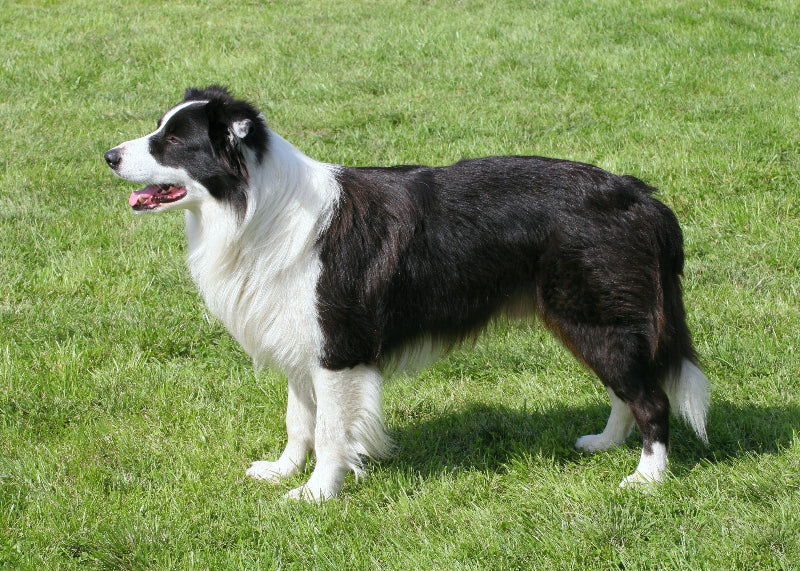
QUICK FACTS
Height: 45–55 cm (males), 40–50 cm (females)
Weight: 14–20 kg (males), 12–19 kg (females)
Lifespan: 12–15 years
Breed Group: Working / Herding
Energy Level: Hyper
Temperament:
Intelligent, alert, loyal, energetic
Shedding Level:
Moderate to high (seasonal blowouts)
Grooming Needs:
Moderate – weekly brushing + seasonal care
- Breed Overview
- Physical & Appearance
- Personality
- Health & Diet
- Grooming & Care
- Cost & Owership
- Download Full Guide
Origins of Border Collies
Border Collies got their start in the rugged hills of Scotland more than 350 years ago, built for brains, stamina, and serious herding skills. During the great droving days of the 18th century, they became the go-to dogs for guiding livestock across the English and Scottish countryside.
The breed as we know it today was shaped by a legendary dog named Old Hemp, whose calm, instinctive style became the blueprint for generations of Borders to come. By the early 1900s, they’d made their way to Australian farms, and in 1953, they were officially recognised as an Australian Working Dog.
While they’re not technically an Aussie breed, Australia has played a huge role in shaping their legacy, especially in the show ring. Known here as the Country of Development for Border Collies in conformation, we’ve helped refine both their look and their temperament. Today, they’re just as likely to be seen excelling in agility competitions as they are rounding up sheep.

BREED SUMMARY
Originating from the windswept borderlands of Scotland and England, the Border Collie is celebrated as the gold-standard herding dog—energetic, incredibly intelligent, and ideally suited for demanding work. This breed is descended from famous sheep-droving dogs, such as Old Hemp, and has been further refined in Australia’s show rings. Today’s Border Collie features a lean, athletic build, standing between 45–55 cm tall and weighing 12–20 kg. With an intense, all-knowing gaze, they seem to ask, “What’s the job?” Their double coat can be smooth or rough and comes in various colors beyond the classic black-and-white. However, moderate shedding escalates into significant “coat blowouts” during autumn and spring.
Intelligence is the hallmark of the Border Collie. They not only learn commands but also read body language, anticipate tasks, and solve problems on the fly. Such brilliance requires structure in daily life, which should include 60–90 minutes of vigorous exercise along with mental challenges like agility training, nose work, or trick sequences. Without adequate engagement, these dogs will invent their own activities—often involving your children, cats, or furniture. Positive, reward-based training from an early age, along with consistent routines, helps channel their herding instincts and prevents frustration-driven behaviors like nipping or obsessive chasing.
Caring for a Border Collie focuses more on mental stimulation than grooming. Weekly brushing (daily during shedding seasons), baths every couple of months, and regular checks for grass seeds will keep their coat healthy. Preventative veterinary care is essential to protect against issues such as hip dysplasia, epilepsy, and Collie Eye Anomaly. A high-protein diet rich in omega-3 fatty acids and joint-support supplements will fuel their constant activity, while early socialization ensures they are comfortable around children, other dogs, and new environments. For active households willing to provide a task for them each day, the Border Collie offers unmatched loyalty, athleticism, and a remarkable intellect that continually impresses.
FAQs About Border Collies
Is a Border Collie a good family dog?
Yes, but only for active families. Border Collies are loyal, intelligent, and generally great with kids if raised together. That said, their natural herding instinct means they may try to “round up” small children, so supervision is essential. They thrive best in households that can meet their high physical and mental needs daily.
What are the disadvantages of a Border Collie?
Their biggest challenges come from their strengths. Border Collies need a lot of exercise and stimulation. Without it, they can become anxious, destructive, or obsessive. They're not ideal for low-energy homes or first-time dog owners looking for a laid-back companion.
Is a Border Collie a high maintenance dog?
Yes, mentally more than physically. While their grooming needs are moderate (weekly brushing and occasional baths), it’s their intelligence and energy that require consistent effort. Daily exercise, training, and enrichment are non-negotiable.
Are Border Collies good to be left alone?
Not for long periods. Border Collies get bored easily and may resort to barking, chewing, or digging when left alone too often. If you work full-time away from home, consider doggy daycare, a dog walker, or puzzle toys to keep them engaged while you're out.
Coat type
Coat length
Physical & Appearance
Every inch of the Border Collie speaks to its heritage as a high-performance herding dog. With a lean, muscular frame built for endurance, a sharp, intelligent gaze, and an ever-alert stance, their appearance is as purposeful as their personality.
Coat types:
- Rough coat: Medium-length with feathering—more common and suited for all-weather herding
- Smooth coat: Short, dense, and low-maintenance
Both types have a double-layered, weather-resistant coat that offers protection during long days outdoors. Expect moderate year-round shedding, with heavier seasonal blowouts in autumn and spring.
Colour Variations and Distinct Markings
Sure, black and white might be the poster look for Border Collies—but they come in a whole range of coat colours, and every one is uniquely eye-catching. Some of the most common Border Collie colour combos include:
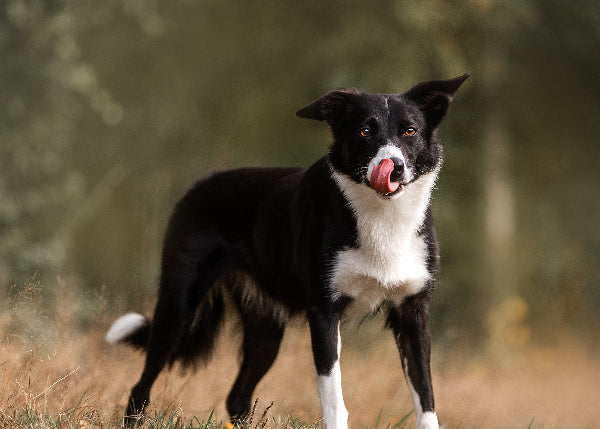
Black & White
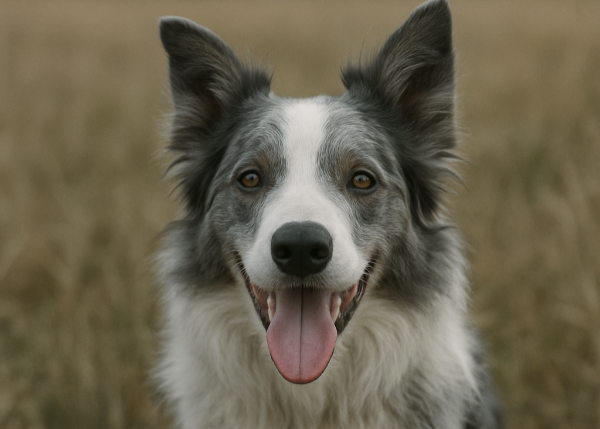
Blue & White

Chocolate & White
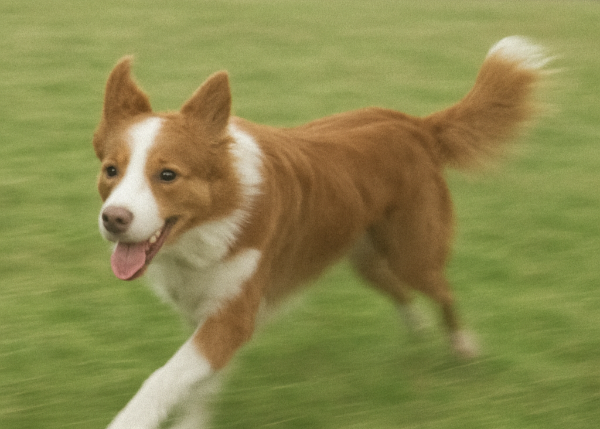
Red & White
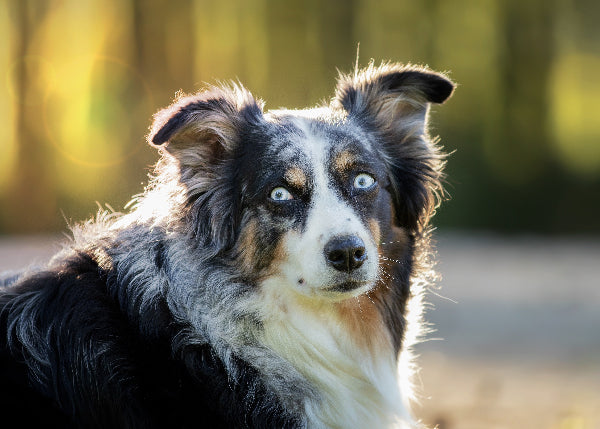
Tricolour (Black/Tan/White)
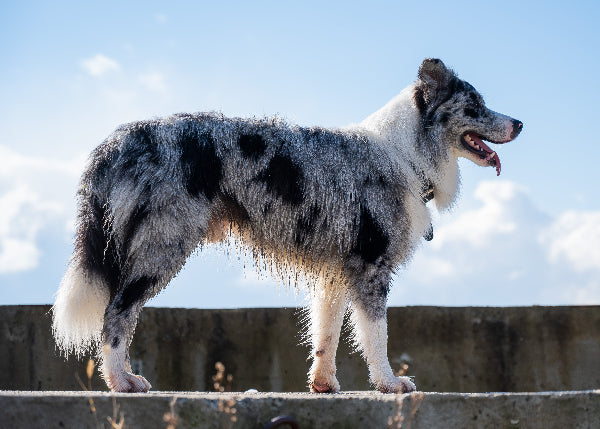
Blue Merle
Their markings? There’s no fixed pattern in the breed standard—just one simple rule: white shouldn't dominate the coat. So as long as the white stays under 50%, it’s all fair game.
Many Border Collies are known for their striking eyes, most commonly a deep, expressive brown. However, in merle-coated individuals, you’ll often see dazzling blue eyes or even heterochromia, where each eye is a different colour, adding to their already captivating presence.
Affectionate with family
Good with kids
Social doggos
Playfulness
Border Collie Temperament & Personality
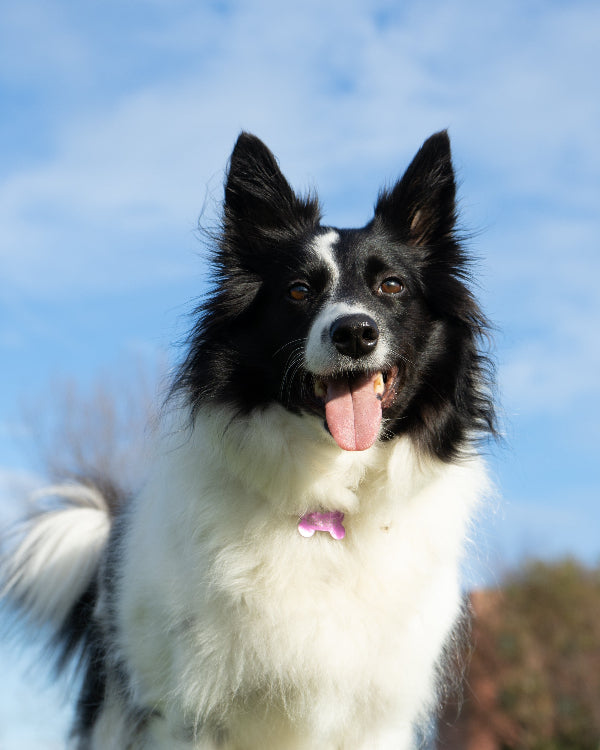
Border Collies are consistently ranked as the most intelligent dog breed, they’re quick learners, problem-solvers, thinkers, and workers through and through.
Intelligence, Work Ethic, and Trainability
Collies are exceptionally trainable. They’re often the top performers in obedience competitions and agility trials, not because they’re forced to, but because they genuinely love the work.
Here’s what sets them apart:
- Problem-solvers: They don’t just follow commands. They learn to read your body language, voice tone, and even anticipate tasks.
- Eager to please: Once bonded, they’ll work hard to get things right, just for a “good dog” or a pat.
- Need structure: They respond best to consistency and routines. Random, unfocused environments can lead to stress or frustration.
- Fast learners: From basic commands to complex trick chains, they’ll pick things up quickly, but that also means they’ll learn bad habits just as fast.
Socialising a Border Collie
Border Collies are wired to tune into their environment, and that includes everything and everyone around them. Their herding instincts are strong, so early socialisation from day 1 helps them understand how to respond appropriately without going into sheepdog mode on your family or the neighbours' cat.
Just remember to limit socialisation with one or two trusted, healthy and fully vaccinated dogs in a safe home environment until your puppy’s vaccination schedule is complete.
Border Collies with Kids and Other Pets
With the right start, Border Collies can be incredible family dogs. But those sharp instincts need direction.
- With kids: They’re attentive and often protective, but may attempt to “herd” children by circling or nipping at heels. It’s not aggression, it’s instinct. Supervision is key, especially with younger children.
- With other dogs: Most Borders get on well with other dogs, especially those who match their energy and don’t mind intense eye contact. Early introductions help set the tone.
- With cats and small pets: Some Border Collies live peacefully with cats, while others see them as moving targets. Introduce slowly and supervise until you’re sure.
- At home: Once exercised, they’re calm indoors and tend to keep a close eye on their people, always waiting for the next task or game.
- With strangers: Naturally reserved. They warm up in their own time, usually showing affection only after trust is earned.
- When left alone: Long solo hours aren’t ideal. Without enough interaction and purpose, boredom leads to barking, pacing, or digging.
Behavioural Issues
Without enough exercise or mental stimulation, Border Collies can develop behavioural problems, like obsessive chasing, anxiety, or destructive boredom-based habits. These often stem from unmet working instincts and may need professional training support.
Tips to Avoid Excessive Herding and Nipping
That classic crouch-and-stare is a Border trademark, but too much of it in the wrong context can be tricky. Here’s how to guide it early:
- Start between 8–16 weeks: This is the prime window for shaping behaviour and building confidence.
- Reward calm: Praise your pup when they stay relaxed around people, pets, and unfamiliar situations.
- Redirect herding: If you spot stalking or nipping, use a simple command like “leave it” or offer a toy to shift focus.
- Control the setting: Skip busy parks at first. Go for low-pressure environments where they can observe without being overwhelmed.
- Keep it going: Socialisation isn’t just for pups—it’s a lifelong skill that improves with regular, positive practice.
Border Collie Lifespan & Health Issues
The average lifespan of a French Bulldog ranges between 10 to 14 years. While they may not have the longest life expectancy among dog breeds, their quality of life can be incredibly fulfilling, with the right preventative veterinary care, nutrition, and environment. French Bulldogs often require significant veterinary support throughout their lives but can live comfortably and are beautiful little personalities for dedicated families.
As a breed, Frenchies benefit from early bonding, consistent routines, and close companionship. They thrive when treated as true family members. Owners who stay proactive with health checks, diet, and lifestyle choices often see their French Bulldogs live well into their teenage years.
Common Health Problems in Border Collies
Border Collies are generally a healthy breed, but like all dogs, they’re prone to certain conditions, especially if they don’t come from a responsible breeder or don’t get regular preventative care. Here are some of the most common health issues seen in the breed:
1. Hip and Elbow Dysplasia & Arthritis
These joint issues can lead to lameness, stiffness, and reluctance to exercise, especially as your dog ages. Arthritis may follow if the joints wear down over time. Signs include limping, trouble with stairs, or hesitation to get up after resting. Diets rich in omega essential fatty acids, such as fish oil, which is full of EPAs and DHAs, will fight chronic inflammation and arthritis symptoms. Superfoods like green lipped mussel powder are also fantastic for protecting joints and joint fluid.
2. Epilepsy
A brain disorder that causes seizures, often starting as young as six months. While the seizures might look intense, they’re not usually painful and can often be managed with medication for a good quality of life.
3. Collie Eye Anomaly (CEA)
An inherited eye condition affecting the retina and optic nerve. It can range from mild vision issues to serious sight loss. Reputable breeders will perform routine screening, which is key.
4. Progressive Retinal Atrophy (PRA)
Another vision condition where the eyes slowly deteriorate over time, often leading to blindness.
5. Urinary Incontinence
More common in spayed females, this condition causes unexpected urine leakage, usually due to a weak bladder sphincter. Thankfully, it’s usually manageable with medication.
Regular Vet Checkups and Preventative Care
Routine vet care goes a long way toward keeping your Border Collie healthy and happy.
- Puppies: Vet visits every 3–4 weeks until the full vaccination series is complete. X-rays of the hips at around 16 weeks of age (Penn Hip Scores) can be useful to check if your Border Collie is developing hip dysplasia.
- Adults: Annual check-ups with a full physical exam and dental cleaning.
- Seniors (7+ years): Biannual visits with added routine blood work, and an ultrasound every 1 to 2 years, to catch age-related issues early
- Parasite Prevention: Regular flea, tick, and worming treatments — monthly or quarterly as recommended by your vet
- Dental care: Brush their teeth 2–3 times per week or use dental chews
- Weight checks: These high-energy dogs should stay lean—excess weight can strain joints
Joint support: Ask your vet about supplements like fish oil and green lipped mussel powder as your Border ages.
Border Collie Nutrition & Diet Guide
A typical 20kg adult Border Collie will do well on 2 cups per day of Petzyo’s Chicken & Turkey kibble, split into two meals. Active dogs may need more, so always adjust to their lifestyle and body condition.
Best Diet for a Border Collie
- Choose a high-protein, balanced food: Look for formulas rich in real meat proteins, omega-3s, and joint-supporting nutrients like omega-3s from fish oil.
- Stick to a schedule: Feeding at the same time each day helps support digestion and avoid begging.
- Optional add-ons (with your vet’s OK): Fish oil for joints and coat health, pre- and probiotics for gut support or tryptophan from salmon or turkey to promote calm.
- Fresh water should always be available, especially after a run or during warmer weather.
Need help picking the right food? Petzyo’s Raw Royalty and Kibble That Counts are both formulated for working dogs like Borders. But don’t stress, whether you’re switching from another brand or just need to know how much Petzyo to serve,our feeding calculator is here to help.
Managing Weight and Preventing Obesity
Even with all that energy, Borders can pack on the kilos if their exercise drops or treat tally adds up.
- Use a measuring cup or digital scale for portion control
- Limit treats to training rewards, not daily snacks
- Feel for ribs, not see them: That’s the healthy balance
- Stick to routine feeding to avoid boredom snacking
Worried about your dog’s weight? Don’t miss our blog on How to Help a Dog Lose Weight for practical, vet-approved tips.
Shedding Amount
Drooling
Coat Grooming Needs
Trainability
Mental Stimulation Needs
Border Collie Grooming & Maintenance
From their thick double coat to their all-weather adventures, here’s how to keep your Border looking great and feeling even better.
Grooming Essentials: Managing Their Double Coat
Border Collies have a dense double coat that keeps them warm and dry, but this also means they require regular brushing, especially during seasonal changes.
Here’s how to manage their coat:
- Brush 2–3 times a week to stay on top of loose fur.
- Daily brushing during autumn and spring when they shed more (you’ll notice the fluff!).
- Use a slicker brush or undercoat rake to reach the thick undercoat.
- Always check for grass seeds, burrs, and dirt, especially after off-lead runs.
- Regular brushing also spreads natural oils, helping their coat stay shiny and healthy.

How Often Should You Bathe a Border Collie?
Good news—Border Collies don’t need baths too often. Their coat stays clean naturally, unless they get into something stinky or muddy. Ensuring a diet rich in omega-3 fatty acids such as fish oil will ensure a strong skin barrier and silky hair coat.
Bathing basics:
- Every 8–12 weeks is usually enough.
- Use a dog-friendly shampoo that’s gentle on their skin.
- Dry them properly—their thick coat holds moisture, which can cause skin issues if left damp.
- Get them used to bath time early, so it becomes part of the routine (and less of a mission later).
Bonus tip: If they’ve been in saltwater or muddy puddles, a quick rinse with fresh water helps protect their skin and coat between baths.
Training & Exercise Needs for Border Collies
If there’s one thing a Border Collie won’t do, it’s sit still for long. These sharp-minded working dogs need more than just a backyard and a comfy bed. Their day needs structure, purpose, and plenty to do, or they’ll invent a job of their own (and you might not like it).
How Much Exercise Do Border Collies Need?
Here’s what they need to stay out of mischief:
- Minimum 60–90 mins daily: Think long walks, off-lead sprints (in safe spaces), or weekend hikes.
- Mental workout = essential: Trick training, nose games, or scent work help burn mental steam.
- Interactive play: Games like fetch, tug-of-war, and obstacle courses build fitness and trust.
- Running mates: Borders make brilliant jogging, biking, or trail-walking buddies.
- Herding instincts are strong, so recall training is a must before going off-lead. Try out Sheep Herding for City Dogs in your region.
Keeping Them Happy & Mentally Stimulated
Border Collies need to be mentally stimulated, or they will make their own fun, and it’s rarely good news for your sofa.
Here’s how to keep their brain buzzing:
- Puzzle toys & snuffle mats: Turn mealtime into a game and keep them focused.
- Teach complex tricks: Borders can learn toy names, tidy up their own playthings, and more.
- Verbal praise goes a long way: They love being told they’ve done a good job.
- Rotate toys weekly to keep their interest fresh.

Training a Border Collie
Border Collies are smart, really smart. But all that brainpower needs direction. Border Collies love having something to do. Teaching them simple commands is easy, but keeping them busy every day is where the real work comes in.
Tips for training success:
- Start early: Socialise from day 1 and then begin with basic obedience at 8–10 weeks of age. Use short, fun sessions daily.
- Positive reinforcement works best: Rewards like treats, toys, or praise help reinforce the right behaviours without creating stress.
- Mental workouts matter: Puzzle toys, hide-and-seek, and advanced trick training are just as important as physical exercise.
- Keep sessions short and varied: 5–10 minutes, 2–3 times a day is more effective than one long drill.
Training Techniques for First-Time Border Collie Owners
Never trained a dog before? Don’t stress. Border Collies can be a challenge, but they’re very rewarding with the right approach.
- Stick to routines: Feed, walk, and train at the same times each day.
- Use clear, consistent cues: Don’t swap between “come” and “here”, pick one and stick to it.
- Avoid harsh corrections: Borders are sensitive to tone and energy. Gentle redirection works far better than raised voices or punishment.
- Reward calm behaviour: Don’t just praise tricks, reward when they settle quietly, too. It helps build emotional regulation.
Need a solid starting point? Check out our guide on the Foundations of Puppy Training to build good habits from day one.
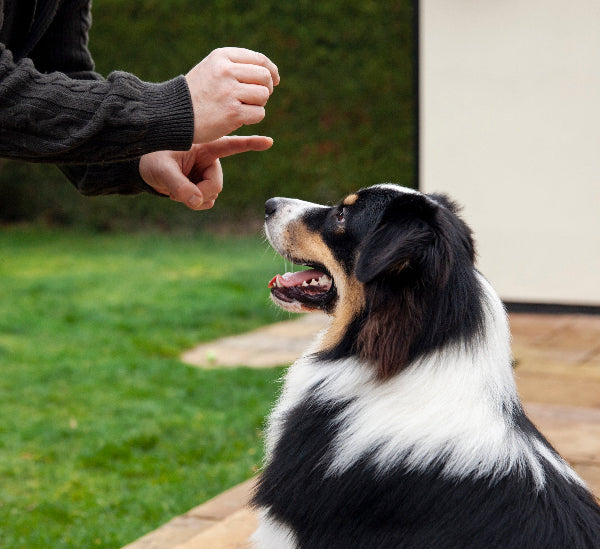
How to Manage Their Herding Instincts
Herding is in the Border Collie’s DNA, it won’t go away, but you can guide it.
- Redirect chasing: If your dog tries to herd kids, bikes, or cats, teach a strong “leave it” or “recall” cue.
- Offer a “job”: Herding breeds do best when they have something to focus on—agility training, frisbee, nose work, or even learning the names of toys.
- Supervise play: Around smaller pets or kids, watch for crouching, stalking, or circling. These are herding behaviours, not aggression, but they need redirection.
Teach impulse control: “Place,” “wait,” and “watch me” are useful commands to refocus their energy.
Cost & Ownership Considerations
Owning a Border Collie means embracing their need for structure, stimulation, and connection. They’re adaptable, but they don’t do well on autopilot. Whether you’re in the suburbs, the city, or the bush, these clever canines need an environment that matches their mental and physical drive.
How much does a Border Collie cost?
In Australia, a Border Collie puppy from a reputable breeder typically costs between $2,000 and $4,500, depending on lineage and whether they’re bred for work, show, or companionship. Ongoing costs, including food, health care, training, and gear, can average $1,500–$2,500 per year.
Can Border Collies Live in Apartments?
Yes, but only if you’re committed.
- Daily exercise isn’t optional: They’ll need at least two solid walks, off-lead time (in safe areas), and mental enrichment.
- Apartment-friendly routines include puzzle toys, training sessions, and structured play indoors.
- They won't thrive being left alone all day, flexible schedules or doggy day care can help.
If you’re in a smaller space, think of their lifestyle as that of a working dog with a gym membership. Burn the energy, and they’ll be calm indoors.
How They Adapt to Different Climates
Border Collies are built tough. Their double coat is surprisingly adaptable across a range of Aussie climates, but they still need a helping hand.
- Hot weather: Walk during cooler hours, avoid midday heat, and always provide shade and water. Watch for signs of overheating, like heavy panting or drooling.
- Cold weather: Their coat offers natural insulation, but a lightweight dog jacket can help older dogs or leaner Borders stay comfortable.
- Wet weather: Rain won’t slow them down, but towel drying after wet walks helps prevent skin irritation or hotspots.
Travelling with a Border Collie
Border Collies are usually up for a road trip or flight, just make sure their travel setup matches their needs.
In the Car:
- Use a secure crate or seatbelt harness
- Pack water, a blanket, and a favourite toy or chew
- Stop every few hours for toilet breaks and movement
- Never leave them loose in the tray of a ute or roaming in the car
Flying Tips:
- Check airline rules and crate size requirements
- Use direct flights when possible
- Line their crate with something that smells like home
- Confirm microchip and ID details are up to date
- Schedule an appointment with your vet for health clearance to fly
- If flying to Tasmania, check all worming requirements are met
- Enlist help from a reputable pet transport company
They’ll enjoy being part of your adventure, as long as they’re safe, secure, and properly exercised before takeoff.
